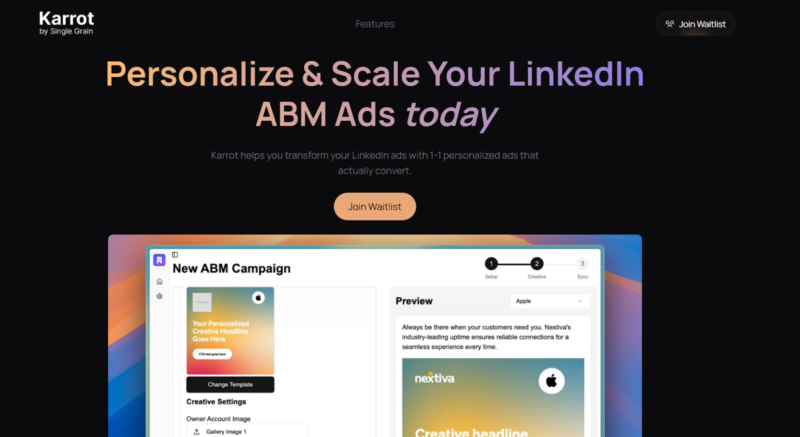Coordinating Multi-Channel Campaigns With LinkedIn ABM: Strategies for Synchronization
Account-based marketing is only effective if your brand has a presence where B2B buyers are. And for most professionals, that place is LinkedIn.
Still, it can be easy to rely on the business networking platform. While LinkedIn provides a powerful platform for ABM execution, the most effective campaigns coordinate LinkedIn efforts with other channels to create a cohesive, multi-touch experience for target accounts.
Taking advantage of multiple channels, from paid media to email marketing, will open up more doors and get your brand in front of many decision-makers. But how do you create a seamless connection between all these channels?
This guide will teach you how to align your messaging and create an integrated experience for coordinating multi-channel campaigns.
Key Highlights
- Multi-channel ABM campaigns generate 80% higher engagement rates than single-channel approaches.
- 97% of marketers report that ABM delivers a higher return on investment than other marketing strategies.
- Synchronized messaging across channels increases conversion rates by 35-45%.
- Cross-channel attribution models are essential for understanding the true impact of coordinated campaigns.
- Channel sequencing significantly impacts campaign performance and conversion rates.
- AI-powered tools like Karrot.ai enable personalization consistency across multiple channels.
- Integrated technology stacks are critical for successful multi-channel coordination.
- Closed-loop measurement provides insights for continuous optimization across channels.
TABLE OF CONTENTS:
The Multi-Channel Imperative for LinkedIn ABM
LinkedIn has emerged as the premier platform for ABM execution due to its professional focus and robust targeting capabilities. Plus, LinkedIn marketing comes with an ROI of 20%, attracting more accounts and increasing profits in one place.
However, the most successful ABM programs recognize that LinkedIn is just one touchpoint in a complex buying journey. When ABM marketers use a multi-channel approach, they see a 60% increase in revenue for each account.
The B2B Buying Reality

Buying behaviors are constantly changing, and this extends to the B2B space. For brands to sign on more accounts, they must adapt to shifting behaviors. Here are some statistics to keep in mind:
- The average B2B buying committee includes 7-20 decision-makers.
- Decision-makers consume 13 pieces of content before making a purchase.
- 70% of the buying process occurs before prospects engage with sales.
- Buyers engage across 4-5 different channels during their decision journey.
- Different stakeholders prefer different communication channels.
A successful ABM campaign requires a coordinated approach that meets target accounts where they are, guiding them down the sales funnel with consistent messaging across all touchpoints.
The Multi-Channel ABM Framework
Multi-channel ABM requires unified content and messaging across all platforms. At its core is a structured framework that connects LinkedIn with other channels. Here’s how to get started with this approach.
Channel Ecosystem
The first step is to identify your network of touchpoints for your ABM campaign and how to use them to reach your ideal customer. Start by developing a comprehensive view of these available channels:
| Channel Category | Examples | Strengths | Coordination Role |
|---|---|---|---|
| Paid Media | LinkedIn Ads, Display, Search | Awareness, targeting | Initial engagement |
| Owned Media | Website, Blog, Resources | Education, conversion | Destination for paid |
| Nurture, Direct Outreach | Personalization, frequency | Follow-up to engagement | |
| Direct Mail | Dimensional, Printed | Cut-through, memorability | Reinforcement of digital |
| Events | Webinars, In-Person | Interaction, relationship | Deepening engagement |
| Sales Outreach | Calls, Personalized Messages | Human connection | Conversion acceleration |
Synchronization Framework
Implementing a structured approach to your channels involves more than copying and pasting the same messages across all platforms. Brands must create comprehensive ideal customer profiles (ICP) for each channel to understand each account and why it may use that communication method.
Plus, each platform has its own processes and tools that can impact the type of content you’ll post.
Here are some considerations for synchronizing your channels:
- Message alignment: Consistent value proposition across channels.
- Visual consistency: Cohesive design language across touchpoints.
- Timing coordination: Strategic sequencing of channel activities.
- Data integration: Shared insights across channel platforms.
- Experience continuity: Seamless transitions between channels.
This framework ensures coordination happens at multiple levels.
Step 1: Develop an Integrated Channel Strategy
Establish a clear multi-channel strategy before executing coordinated campaigns. This involves creating your buyer’s journey, mapping out the customer journey, and choosing which channels to prioritize.
Channel Role Definition
Define the specific role each channel plays in the ABM program. Some of the most effective ones include:
- LinkedIn: Precision targeting and initial engagement.
- Display advertising: Broader awareness and retargeting.
- Email: Personalized nurturing and direct communication.
- Website: Conversion destination and content hub.
- Direct mail: High-impact touchpoints for key accounts.
- Sales outreach: Personal connection and opportunity advancement.
- Events: Interactive engagement and relationship building.
If your audience follows you on all channels, they should consume the same message regardless of the platform they’re currently on.
Account Journey Mapping
The account journey map is a visual representation of the buying process. Here are the most common steps and suggested content:
- Awareness Stage: LinkedIn thought leadership, targeted display.
- Education Stage: LinkedIn content promotion, email nurture, website resources.
- Consideration Stage: LinkedIn case studies, webinars, direct mail.
- Decision Stage: LinkedIn conversion ads, sales outreach, in-person events.
- Expansion Stage: LinkedIn relationship content, account-specific events.
This journey mapping ensures channels are coordinated around the buyer’s process rather than internal organizational structures.
Channel Prioritization by Segment
Segmenting accounts is an effective way to pinpoint different characteristics and deliver consistent messages to these individual groups. This example shows segmenting accounts by volume, but you can separate leads in other ways.
| Account Segment | Primary Channels | Secondary Channels | Tertiary Channels |
|---|---|---|---|
| Tier 1 (Top Accounts) | LinkedIn, Direct Mail, Sales | Email, Events, Website | Display, Search |
| Tier 2 (High Value) | LinkedIn, Email, Website | Sales, Events, Display | Direct Mail, Search |
| Tier 3 (Volume) | LinkedIn, Email, Website | Display, Search | Events, Direct Mail |
Step 2: Implement Message and Creative Synchronization
Consistent messaging across channels is essential for campaign effectiveness. Here’s how to achieve this.
Message Architecture
Develop a unified message matrix that works across channels. Here’s an example:
- Core value proposition: Central benefit or urgency that remains consistent.
- Supporting messages: Key points that reinforce the core proposition.
- Channel-specific articulations: How messages adapt to each channel.
- Segment variations: How messages adjust for different audiences.
- Stage-based evolution: How messages progress through the journey.
This structured approach ensures messaging remains consistent while adapting appropriately to each channel’s format and context.
Visual System Development
Create a cohesive visual system for multi-channel campaigns:
- Core visual elements: Key design components that remain consistent,
- Channel adaptations: How visuals adjust to different formats.
- Recognition patterns: Visual cues that create cross-channel recognition.
- Format requirements: Technical specifications for each channel.
- Asset management: System for organizing and distributing visual elements.
This visual system ensures target accounts experience a cohesive brand presence regardless of where they encounter your content.
The Karrot.ai Advantage

Platforms like Karrot.ai enhance multi-channel synchronization through:
- Cross-channel personalization that maintains consistency while adapting to formats.
- Centralized creative management that ensures alignment across touchpoints.
- Automated asset generation for different channel requirements.
- Performance tracking across the entire channel ecosystem.
- AI-powered optimization that refines messaging across all channels.
This integrated approach eliminates the silos that typically undermine multi-channel coordination, creating a genuinely synchronized experience.
Step 3: Coordinate Channel Sequencing and Timing
Strategic sequencing significantly impacts campaign effectiveness. Here’s how to implement this in your ABM campaign.
Sequence Optimization
Develop optimal channel sequences and how you can create interactions for different scenarios. Here’s an example strategy:
Awareness
- LinkedIn thought leadership ads.
- Targeted display retargeting.
- Personalized email follow-up.
- Sales Navigator connection request.
Engagement
- LinkedIn content promotion.
- Email content delivery.
- Direct mail reinforcement.
- Sales outreach follow-up.
Conversion
- LinkedIn case study promotion.
- Webinar invitation email.
- Direct mail with an offer.
- Sales meeting request.
These orchestrated sequences ensure channels work together in a complementary fashion rather than competing for attention.
Timing Optimization
Implement strategic timing approaches:
- Simultaneous impact: Coordinated multi-channel launch for maximum visibility.
- Sequential progression: Staged rollout across channels for journey advancement.
- Trigger-based activation: Channel activities initiated by specific behaviors.
- Optimal day/time targeting: Channel-specific timing based on engagement patterns.
- Frequency management: Coordinated cadence across all touchpoints.
This timing strategy ensures account experiences are appropriately paced.
Automation Implementation
Marketing automation can streamline content creation and management across all channels. The right tools can help you create and schedule posts in one place, ensuring brands use consistent messaging, branding, and timing.
Here are additional ways that automation can improve your multi-channel campaign:
- Workflow automation: Streamlined processes for cross-channel execution.
- Trigger-based rules: Automated channel activities based on behaviors.
- Dynamic scheduling: Optimized timing based on engagement patterns.
- Cross-channel alerts: Notifications about activities across platforms.
- Performance monitoring: Automated tracking of cross-channel metrics.
This automation infrastructure ensures coordination happens consistently without overwhelming manual processes.
Step 4: Integrate Data Across Channels
Data integration is the foundation of effective coordination, but this tactic requires effective customer profiling and real-time data collection and monitoring. Here’s how to get started.
Unified Data Architecture
Implement a comprehensive data integration approach using:
- Central data repository: Single source of truth for account information.
- Cross-channel identity resolution: Connecting individuals across touchpoints.
- Engagement data integration: Unified view of interactions across channels.
- Behavioral insight aggregation: Combined understanding of account activity.
- Attribution modeling: Connected view of channel impact on outcomes.
This unified architecture ensures decisions are based on complete information rather than channel-specific fragments.
Cross-Channel Signals
Identify and leverage signals across channels:
| Signal Type | Examples | Channel Applications |
|---|---|---|
| Engagement Signals | Content interactions, website visits | Trigger LinkedIn retargeting, sales alerts |
| Intent Signals | Product page views, pricing downloads | Activate direct mail, prioritize sales outreach |
| Objection Signals | Competitive content engagement, stalled progress | Adjust LinkedIn messaging, trigger executive outreach |
| Buying Stage Signals | Demo requests, evaluation activities | Modify channel mix, adjust content focus |
| Relationship Signals | Sales interactions, event participation | Refine LinkedIn targeting, personalize email content |
This signal utilization ensures each channel responds appropriately to account behaviors across the entire ecosystem.
Technology Integration Requirements
Choosing the right ABM channels isn’t enough. You also must collect data pipelines for the most accurate integrations. Implement these critical data connections:
- LinkedIn ↔ CRM: Bi-directional flow of account and engagement data.
- Marketing Automation ↔ LinkedIn: Audience synchronization and activity tracking.
- Website Analytics ↔ ABM Platform: Visitor identification and behavior tracking.
- Sales Engagement ↔ Marketing Platforms: Coordinated outreach and feedback.
- Event Platforms ↔ Central Database: Participation tracking and follow-up coordination.
Step 5: Coordinate Sales and Marketing Activities
Alignment between sales and marketing is critical for multi-channel success across an account’s lifecycle. Here are key ways to achieve this.
Sales-Marketing Coordination Framework
Implement a structured coordination approach, such as:
- Shared account intelligence: Joint visibility into account insights.
- Activity transparency: Clear visibility into all touchpoints.
- Coordinated outreach: Synchronized timing of sales and marketing activities.
- Feedback loops: Systematic sharing of account responses.
- Joint planning: Collaborative campaign development.
This framework ensures that sales and marketing function as a unified team rather than separate entities.
Account-Based Plays
Develop coordinated multi-channel plays for specific scenarios:
- New account engagement: Coordinated introduction across channels.
- Opportunity acceleration: Synchronized push when deals slow down.
- Competitive displacement: Multi-channel approach for competitive accounts.
- Event follow-up: Coordinated post-event nurturing.
- Renewal/expansion: Synchronized approach for existing customers.
These orchestrated plays ensure all channels work together toward specific account objectives rather than pursuing separate goals.
Sales Enablement for Multi-Channel
Equip sales teams to participate effectively in multi-channel coordination in ways such as:
- Campaign awareness: Comprehensive briefing on all channel activities.
- Content access: Easy access to all campaign assets.
- Timing alerts: Notifications about marketing touchpoints.
- Engagement insights: Visibility into account interactions across channels.
- Feedback mechanisms: Simple ways to provide input on account responses.
This enablement ensures sales teams can reinforce and complement marketing activities rather than operating in isolation.
Step 6: Implement Cross-Channel Measurement
Comprehensive measurement is essential for understanding coordinated campaign performance. Here are ways to measure the success of your multi-channel campaign.
Multi-Touch Attribution
A multi-touch approach ensures all channels are working together to convert an account. Implement sophisticated attribution to connect activities to outcomes:
- First-touch attribution: Credits the first touchpoint that engaged the account.
- Last-touch attribution: Credits the final touchpoint before conversion.
- Multi-touch attribution: Distributes credit across all touchpoints.
- Position-based attribution: Weights credit based on touchpoint position.
- Time-decay attribution: Gives more credit to recent touchpoints.
The ultimate goal of this strategy is to understand where conversions occur and make other touchpoints support this channel. ABM marketers can also use this data to prioritize spending on the most valuable attributions.
Cross-Channel Analytics Framework
Develop a comprehensive measurement approach by collecting this data:
| Metric Level | Cross-Channel Metrics | Channel-Specific Metrics |
|---|---|---|
| Activity Metrics | Total touchpoints, channel mix | Channel-specific engagement |
| Response Metrics | Account engagement score, journey progression | Channel response rates |
| Impact Metrics | Pipeline influence, revenue contribution | Channel-specific attribution |
| Efficiency Metrics | Cost per acquisition, overall ROI | Channel-specific ROI |
After you gather this data, analyze and visualize it for an all-around view of your account’s journey.
Optimization Feedback Loops
Implement systematic processes for continuous improvement. An example can include:
- Regular performance reviews across all channels
- Cross-channel pattern analysis to identify synergies and gaps
- Channel mix optimization based on performance data
- Sequence refinement to improve journey progression
- Budget reallocation to the highest-performing channel combinations
This closed-loop approach ensures insights drive ongoing improvements across the entire channel ecosystem.
Case Study: Tech Company Transforms Results with Coordinated Multi-Channel ABM
A B2B software company implemented a coordinated multi-channel approach for their ABM program targeting 500 enterprise accounts. By synchronizing LinkedIn with other channels, they:
- Developed an integrated channel strategy with clear roles for each platform
- Created a unified message architecture that maintained consistency across touchpoints
- Implemented strategic channel sequences for different account scenarios
- Integrated data across all platforms for a unified view of account engagement
- Coordinated marketing activities with sales outreach for maximum impact
- Implemented cross-channel measurement to understand true campaign performance
The results demonstrated the power of coordination:
- 187% increase in target account engagement compared to previous siloed campaigns
- 64% improvement in MQL-to-opportunity conversion
- 42% reduction in cost-per-acquisition
- 3.2X return on ad spend across all channels
- $14.7M in influenced pipeline within 6 months
- 28% shorter sales cycles for engaged accounts
Best Practices for Multi-Channel Coordination
To maximize the effectiveness of your coordinated LinkedIn ABM campaigns, follow these proven tips:
- Start with strategy rather than jumping directly to execution
- Define clear channel roles to ensure complementary rather than redundant efforts
- Maintain message consistency while adapting appropriately to each channel
- Implement strategic sequencing based on the buyer’s journey
- Integrate data across platforms for a unified view of account engagement
- Coordinate closely with sales to create a seamless experience
- Measure performance across the entire channel ecosystem
- Leverage AI-powered tools like Karrot.ai to enable consistent personalization
- Continuously optimize channel mix based on performance data
- Document and share learnings to build organizational capabilities
Coordinating Multi-Channel Campaigns Will Bring More Success
With a multi-channel campaign, ABM marketers aim to have a presence where high-value leads gravitate. Even though LinkedIn offers robust targeting capabilities, coordinating multi-channel campaigns boosts engagement rates, conversions, and even ROI.
Having a presence on various channels isn’t enough to attract more high-value accounts. The key is creating a systematic approach that connects all touchpoints into a cohesive account experience rather than a collection of disconnected tactics.
As you implement these strategies for your LinkedIn ABM campaigns, consider how automation tools like Karrot.ai can help you maintain messaging and personalization across multiple channels. AI can also help identify your most successful touchpoints and how they deliver exceptional, measurable results for your business.




